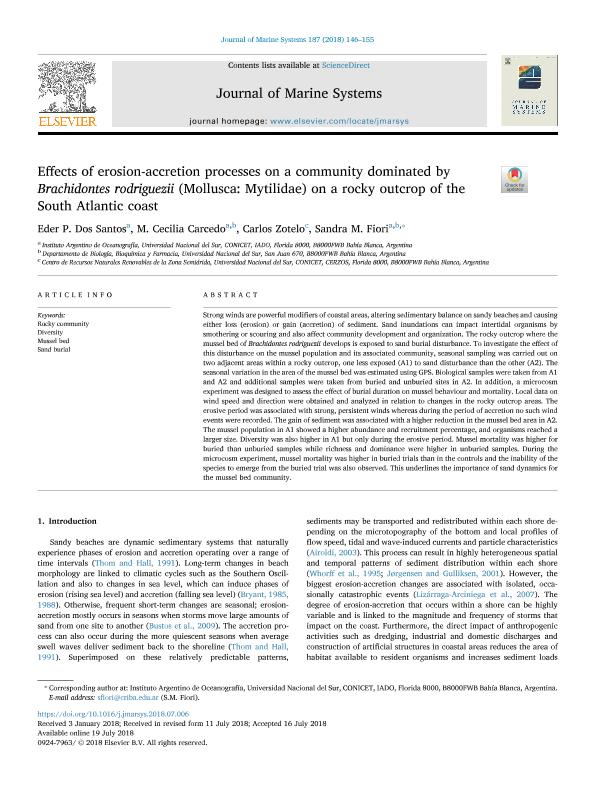Mostrar el registro sencillo del ítem
dc.contributor.author
Dos Santos, Eder Paulo

dc.contributor.author
Carcedo, Maria Cecilia

dc.contributor.author
Zotelo, Carlos Hugo

dc.contributor.author
Fiori, Sandra Marcela

dc.date.available
2019-10-18T15:57:21Z
dc.date.issued
2018-11
dc.identifier.citation
Dos Santos, Eder Paulo; Carcedo, Maria Cecilia; Zotelo, Carlos Hugo; Fiori, Sandra Marcela; Effects of erosion-accretion processes on a community dominated by Brachidontes rodriguezii (Mollusca: Mytilidae) on a rocky outcrop of the South Atlantic coast; Elsevier Science; Journal Of Marine Systems; 187; -11-2018; 146-155
dc.identifier.issn
0924-7963
dc.identifier.uri
http://hdl.handle.net/11336/86369
dc.description.abstract
Strong winds are powerful modifiers of coastal areas, altering sedimentary balance on sandy beaches and causing either loss (erosion) or gain (accretion) of sediment. Sand inundations can impact intertidal organisms by smothering or scouring and also affect community development and organization. The rocky outcrop where the mussel bed of Brachidontes rodriguezii develops is exposed to sand burial disturbance. To investigate the effect of this disturbance on the mussel population and its associated community, seasonal sampling was carried out on two adjacent areas within a rocky outcrop, one less exposed (A1) to sand disturbance than the other (A2). The seasonal variation in the area of the mussel bed was estimated using GPS. Biological samples were taken from A1 and A2 and additional samples were taken from buried and unburied sites in A2. In addition, a microcosm experiment was designed to assess the effect of burial duration on mussel behaviour and mortality. Local data on wind speed and direction were obtained and analyzed in relation to changes in the rocky outcrop areas. The erosive period was associated with strong, persistent winds whereas during the period of accretion no such wind events were recorded. The gain of sediment was associated with a higher reduction in the mussel bed area in A2. The mussel population in A1 showed a higher abundance and recruitment percentage, and organisms reached a larger size. Diversity was also higher in A1 but only during the erosive period. Mussel mortality was higher for buried than unburied samples while richness and dominance were higher in unburied samples. During the microcosm experiment, mussel mortality was higher in buried trials than in the controls and the inability of the species to emerge from the buried trial was also observed. This underlines the importance of sand dynamics for the mussel bed community.
dc.format
application/pdf
dc.language.iso
eng
dc.publisher
Elsevier Science

dc.rights
info:eu-repo/semantics/openAccess
dc.rights.uri
https://creativecommons.org/licenses/by-nc-sa/2.5/ar/
dc.subject
Diversity
dc.subject
Mussel Bed
dc.subject
Rocky Community
dc.subject
Sand Burial
dc.subject.classification
Oceanografía, Hidrología, Recursos Hídricos

dc.subject.classification
Ciencias de la Tierra y relacionadas con el Medio Ambiente

dc.subject.classification
CIENCIAS NATURALES Y EXACTAS

dc.title
Effects of erosion-accretion processes on a community dominated by Brachidontes rodriguezii (Mollusca: Mytilidae) on a rocky outcrop of the South Atlantic coast
dc.type
info:eu-repo/semantics/article
dc.type
info:ar-repo/semantics/artículo
dc.type
info:eu-repo/semantics/publishedVersion
dc.date.updated
2019-08-08T19:33:52Z
dc.journal.volume
187
dc.journal.pagination
146-155
dc.journal.pais
Países Bajos

dc.journal.ciudad
Amsterdam
dc.description.fil
Fil: Dos Santos, Eder Paulo. Consejo Nacional de Investigaciones Científicas y Técnicas. Centro Científico Tecnológico Conicet - Bahía Blanca. Instituto Argentino de Oceanografía. Universidad Nacional del Sur. Instituto Argentino de Oceanografía; Argentina
dc.description.fil
Fil: Carcedo, Maria Cecilia. Consejo Nacional de Investigaciones Científicas y Técnicas. Centro Científico Tecnológico Conicet - Bahía Blanca. Instituto Argentino de Oceanografía. Universidad Nacional del Sur. Instituto Argentino de Oceanografía; Argentina. Universidad Nacional del Sur. Departamento de Biología, Bioquímica y Farmacia; Argentina
dc.description.fil
Fil: Zotelo, Carlos Hugo. Consejo Nacional de Investigaciones Científicas y Técnicas. Centro Científico Tecnológico Conicet - Bahía Blanca. Centro de Recursos Naturales Renovables de la Zona Semiárida. Universidad Nacional del Sur. Centro de Recursos Naturales Renovables de la Zona Semiárida; Argentina
dc.description.fil
Fil: Fiori, Sandra Marcela. Consejo Nacional de Investigaciones Científicas y Técnicas. Centro Científico Tecnológico Conicet - Bahía Blanca. Instituto Argentino de Oceanografía. Universidad Nacional del Sur. Instituto Argentino de Oceanografía; Argentina. Universidad Nacional del Sur. Departamento de Biología, Bioquímica y Farmacia; Argentina
dc.journal.title
Journal Of Marine Systems

dc.relation.alternativeid
info:eu-repo/semantics/altIdentifier/url/https://linkinghub.elsevier.com/retrieve/pii/S0924796317305249
dc.relation.alternativeid
info:eu-repo/semantics/altIdentifier/doi/https://doi.org/10.1016/j.jmarsys.2018.07.006
Archivos asociados
